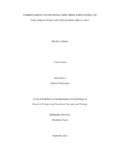
Please use this identifier to cite or link to this item:
https://hdl.handle.net/20.500.14301/98| Title: | UNDERSTANDING OCCUPATIONAL SHIFT FROM AGRICULTURAL TO NON-AGRICULTURAL SECTORS IN SEMI URBAN AREA |
| Authors: | Acharya, Rakshya |
| Issue Date: | 29-Sep-2021 |
| School: | SOED |
| Department: | DODE |
| Level: | Masters |
| Program: | MTVET |
| Series/Report no.: | Acharya, R. (2021). Understanding Occupational Shift from Agricultural to Non-Agricultural Sectors in Semi-Urban Area. [Unpublished dissertation], Kathmandu University. ]; |
| Abstract: | Despite considering agriculture as the primary economic sector, people in Nepal are rapidly moving away from this sector. Occupational shift from the traditional sector such as agriculture to the industrial sector and service sector is a global phenomenon because of modernity, urbanization, and search for comfortable life of people. People in Nepal also are abandoning agriculture as an occupation because of changing life styles, modernity, and national planning. As a result, the infantile industrial growth and insufficient employment generation in the service sector compelled thousands of youths to migrate daily to foreign lands for employment. Even within the country, youths migrating from rural to the urban area leaving their traditional agriculture occupation is a common phenomenon. This scenario made this researcher curious to understand the phenomenon of occupational shift and the dynamics of various elements playing a role behind it. To pursue the research purpose, a qualitative research design with the strategy of narrative inquiry was adopted to understand the experiences and perceptions of people who were on the verge of occupational shift. The four research participants; two from Kageswori Manohara Municipality and two from Gokarneshwor municipality of Kathmandu valley were purposefully selected for the in-depth interview. In addition to listening and reflecting to their life stories about engagement to abandon agriculture occupation, their activities, emotions, and lifestyle were also narrated, observed and analyzed. The qualitative analysis of participant‟s narrations and observations of their daily life led to the major insights that various economic and socio-cultural dimensions of societal change were primarily associated with the occupational shift. People left agriculture as an occupation when they could not adopt modern technology. Therefore, they had work burden to follow the agriculture. Economic aspects like low and uncertain return from agriculture, comparatively higher benefit from non-farm occupations and access to foreign employment had motivated people for the occupational shift. Likewise, the socio-cultural aspects such as urbanization, changing values of societies, peoples‟ new lifestyle, and education system were also playing a vital role in the background to speed up the process of occupational shift. The dynamics of these elements were viewed from the lenses of the modernization theory whereas analyses were made in the light of macro-micro interaction between structure and agency of the society. Despite remaining the agriculture sector at fading stage at present, the research concludes that potentiality of this sector is still high for the country to generate employment. The research indicates the importance to redefine the agricultural policy to attract youth in it thereby envisioning technical and vocational education. Likewise, the research also demonstrates the possibilities of increasing agricultural productivity and enhancing the social value of this occupation can revive the agriculture occupation again in Nepal by revisiting the education pattern of TVET. |
| URI: | http://101.251.6.110:8080/handle/20.500.14301/98 |
| Appears in Collections: | Research Project |
Files in This Item:
| File | Description | Size | Format | |
|---|---|---|---|---|
| MTVET_Rakshya Acharya.pdf | 1.09 MB | Adobe PDF |  View/Open |
Items in DSpace are protected by copyright, with all rights reserved, unless otherwise indicated.